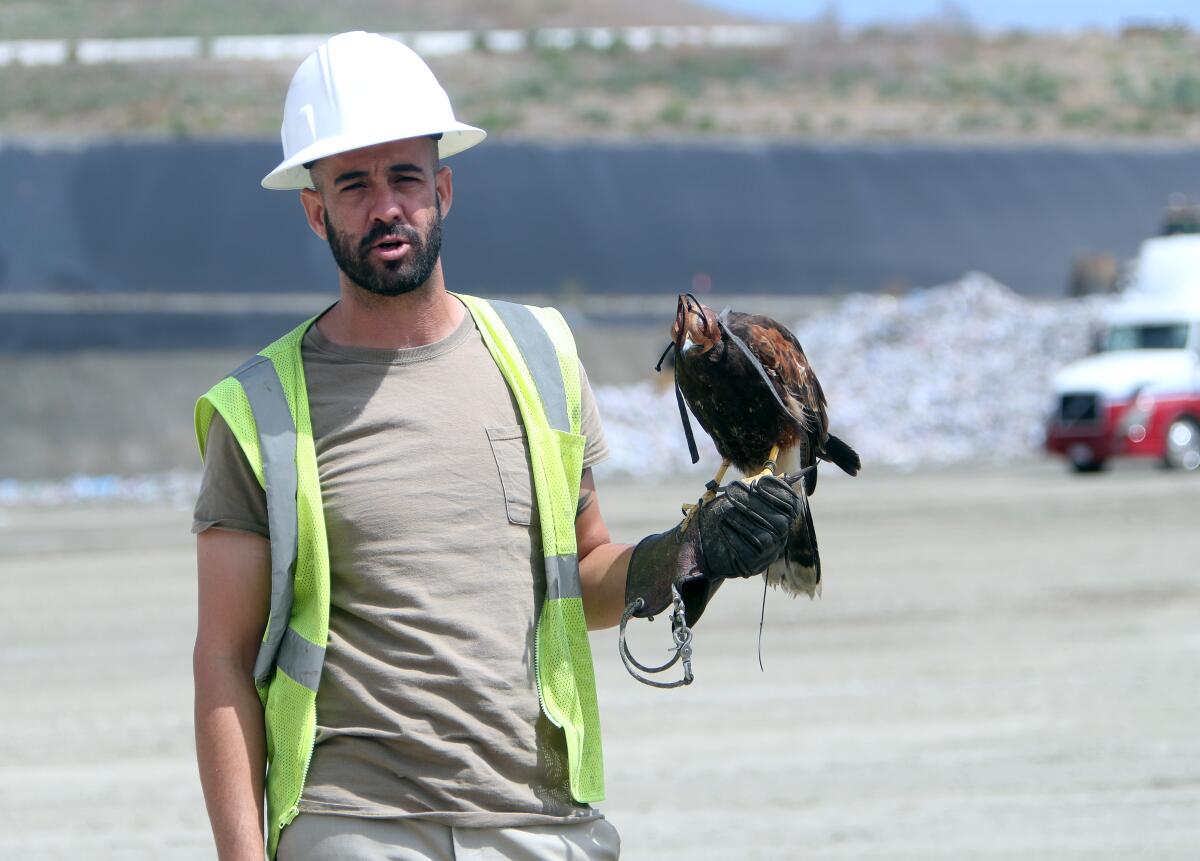Falconers keep Orange County from being overrun by birds

- Share via
Pigeons are controversial.
On one hand, they’ve accomplished a lot.
One pigeon allegedly managed to win over the love of a real-live man — Serbian-American inventor Nikola Tesla. Others apparently understand the nature of space and time. They even worked for us during World War II, ferrying messages to and from camps.
On the other hand, they defecate.
It is this activity that has led to the pigeons’ current public relations crisis. People don’t like to be pooped on.
Enter Adam Chavez.
The San Juan Capistrano resident has been running his company, Adam’s Falconry Service, for about seven years. The business works with Orange County, various cities, homeowner’s associations and hotels to reduce the number of nuisance birds — pigeons, seagulls, crows — in areas where they congregate, like landfills, beaches and agricultural areas.
About a dozen staff members are spread throughout California, though many are based in Orange County. Each member is a certified falconer.
Chavez said bird abatement with predator raptors has become more common over the years in the U.S. because it’s preferable to many of the other methods.
“You can try all kinds of gadgets — you see spikes and poisons,” Chavez said. “That all works to a certain extent, but its not going to solve the problem. The birds are going to work around it. Nothing works as good as birds of prey. It’s a green and sustainable activity that is natural.”
Chavez and his falconers use hawks and falcons for the job. Though these predator birds naturally eat smaller birds, Chavez and his team make sure there is no bloodshed. The predators merely haze the birds until they decide not to return.
“You have to create a predator presence,” Chavez said. “People always ask, ‘How long does that take?’ But every project is different. If birds have been going there for years, they aren’t just going to give it up and fly away.”
Bird abatement is used in a variety of situations — birds may be stealing food from hotel restaurants or produce from a farm. Airports may hire falconers because there are too many birds “striking” planes. According to the FAA, planes collided with wildlife 14,661 times in 2018.
There are about 30 abatement birds in Chavez’s company. Chavez trains the birds in the initial stages.
Using a basic Pavlovian reward method, it can take about a month to train a hawk before it can go to work, though they need to be eased into the abatement role. It takes longer for falcons.
“The hawks turn out really quick, but the falcons take a lot longer because they mature slower,” Chavez said. “You are teaching them a lot of different things, not just flying from Point A to Point B like a hawk.”
Peregrine falcons can fly as high as .62 miles and reach about 200 mph.
“I don’t judge a falcon until I have had it for three years,” Chavez said. “I had this one falcon who was my worst at the end of year two, but by year three, he was incredible.”
The company was hired by the county of Orange about seven years ago to solve a seagull problem at the Prima Deshecha Landfill in San Juan Capistrano. Chavez said the landfill had about 5,000 seagulls when they started. There are now about 300 to 400, he estimated.
Other than the landfill, Chavez didn’t want to divulge specific locations where his falconers are assigned, but he did say they work in San Juan Capistrano, Newport Beach, Irvine, Laguna Niguel, Laguna Beach and Dana Point.

David Feliciano, a falconer with Adam’s Falconry Services, spends about six to 10 hours a day at the San Juan Capistrano landfill, depending on the season.
Though falconers choose from a variety of falcons and hawks based on the scenario, Feliciano tends to prefer his most trusted hawk, Bollo. When not pursuing seagulls, Bollo perches on Feliciano’s gloved arm with a hood over his eyes to keep him calm.
Bollo will chase out the offending seagulls while Feliciano monitors the situation. The hawk has a tracking device fixed to him so Feliciano doesn’t lose him.
The work is a passion for Feliciano.
“I always loved animals,” he said. “I was always hunting for lizards and snakes. It’s a common progression for falconers to move from interest in insects, to reptiles to birds.”
Feliciano began his work as a falconer about four years ago under Chavez’s tutelage.
“Adam is a master at this,” Feliciano said. “He’s been doing this forever.”
Chavez has also been fascinated with nature since he was a child. While growing up in Carson City, Nev., Chavez spent much of his time hunting and fishing. When he was 12, he and some friends found a group of young kestrel falcons.
“We thought they had been abandoned, and we took them home to save them,” Chavez said.
The experience led Chavez to get his falconer license the same year. He maintained falconing as a hobby for most of his life while working as a stockbroker and pharmaceutical salesman until he was able to open his business.
“It’s really like bird watching, but you are up close and personal,” Chavez said. “You get to see things that happen in the wild that others don’t get to see.”
In addition to the company’s abatement services, Chavez also holds a falconry school a couple times a month at A Stone’s Throw Winery in San Juan Capistrano. Students can learn the ins and outs of falconry and have a chance to handle the birds.
The company also helps with conservation efforts, rehabilitating injured peregrine falcons, so they can be released back into the wild.
For more information about the falconry school, visit adamsfalconryservice.com.
All the latest on Orange County from Orange County.
Get our free TimesOC newsletter.
You may occasionally receive promotional content from the Daily Pilot.






